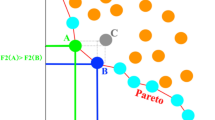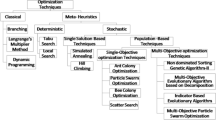Abstract
Let us suppose that A and B are nonempty subsets of a metric space. Let S:A⟶B and T:A⟶B be nonself-mappings. Considering the fact S and T are nonself-mappings, it is feasible that the equations Sx=x and Tx=x have no common solution, designated as a common fixed point of the mappings S and T. Eventually, when the equations have no common solution, one contemplates to figure out an element x that is in close proximity to Sx and Tx in the sense that d(x,Sx) and d(x,Tx) are minimum. In fact, common best proximity point theorems scrutinize the existence of such optimal approximate solutions, known as common best proximity points, to the equations Sx=x and Tx=x in the event that the equations have no common solution. Further, one can perceive that the real-valued functions x⟶d(x,Sx) and x⟶d(x,Tx) estimate the magnitude of the error involved for any common approximate solution of the equations Sx=x and Tx=x. In light of the fact that the distance between x and Sx, and the distance between x and Tx are at least the distance between A and B for all x in A, a common best proximity point theorem ascertains global minimum of both functions x⟶d(x,Sx) and x⟶d(x,Tx) by limiting a common approximate solution of the equations Sx=x and Tx=x to fulfil the requirement that d(x,Sx)=d(A,B) and d(x,Tx)=d(A,B). This article discusses a common best proximity point theorem for a pair of nonself-mappings, one of which dominates the other proximally, thereby yielding common optimal approximate solutions of some fixed point equations when there is no common solution.
Similar content being viewed by others
References
Al-Thagafi MA, Shahzad N (2008) Best proximity sets and equilibrium pairs for a finite family of multimaps. Fixed Point Theory Appl 2008:457069, 10 pp
Al-Thagafi MA, Shahzad N (2009a) Convergence and existence results for best proximity points. Nonlinear Anal 70(10):3665–3671
Al-Thagafi MA, Shahzad N (2009b) Best proximity pairs and equilibrium pairs for Kakutani multimaps. Nonlinear Anal 70(3):1209–1216
Anuradha J, Veeramani P (2009) Proximal pointwise contraction. Topology Appl 156(18):2942–2948
Di Bari C, Suzuki T, Vetro C (2008) Best proximity points for cyclic Meir–Keeler contractions. Nonlinear Anal 69(11):3790–3794
Eldred AA, Veeramani P (2006) Existence and convergence of best proximity points. J Math Anal Appl 323:1001–1006
Eldred AA, Kirk WA, Veeramani P (2005) Proximinal normal structure and relatively nonexpansive mappings. Studia Math 171(3):283–293
Fan K (1969) Extensions of two fixed point theorems of FE Browder. Math Z 112:234–240
Jungck G (1976) Commuting mappings and fixed points. Amer Math Monthly 83:261–263
Karpagam S, Agrawal S (2009) Best proximity point theorems for p-cyclic Meir–Keeler contractions. Fixed Point Theory Appl 2009:197308, 9 pp
Kim WK, Kum S, Lee KH (2008) On general best proximity pairs and equilibrium pairs in free abstract economies. Nonlinear Anal 68(8):2216–2227
Kirk WA, Reich S, Veeramani P (2003) Proximinal retracts and best proximity pair theorems. Numer Funct Anal Optim 24:851–862
Prolla JB (1982–1983) Fixed point theorems for set valued mappings and existence of best approximations. Numer Funct Anal Optim 5:449–455
Reich S (1978) Approximate selections, best approximations, fixed points and invariant sets. J Math Anal Appl 62:104–113
Sadiq Basha S (2010a) Best proximity points: global optimal approximate solution. J Global Optim. doi:10.1007/s10898-009-9521-0
Sadiq Basha S (2010b) Extensions of Banach’s contraction principle. Numer Funct Anal Optim 31:569–576
Sadiq Basha S, Veeramani P (1997) Best approximations and best proximity pairs. Acta Sci Math (Szeged) 63:289–300
Sadiq Basha S, Veeramani P (2000) Best proximity pair theorems for multifunctions with open fibres. J Approx Theory 103:119–129
Sadiq Basha S, Veeramani P, Pai DV (2001) Best proximity pair theorems. Indian J Pure Appl Math 32:1237–1246
Sankar Raj V, Veeramani P (2009) Best proximity pair theorems for relatively nonexpansive mappings. Appl Gen Topol 10(1):21–28
Sehgal VM, Singh SP (1988) A generalization to multifunctions of Fan’s best approximation theorem. Proc Am Math Soc 102:534–537
Sehgal VM, Singh SP (1989) A theorem on best approximations. Numer Funct Anal Optim 10:181–184
Srinivasan PS (2001) Best proximity pair theorems. Acta Sci Math (Szeged) 67:421–429
Vetrivel V, Veeramani P, Bhattacharyya P (1992) Some extensions of Fan’s best approximation theorem. Numer Funct Anal Optim 13:397–402
Wlodarczyk K, Plebaniak R, Banach A (2009) Best proximity points for cyclic and noncyclic set-valued relatively quasi-asymptotic contractions in uniform spaces. Nonlinear Anal 70(9):3332–3341
Author information
Authors and Affiliations
Corresponding author
Rights and permissions
About this article
Cite this article
Sadiq Basha, S. Common best proximity points: global minimal solutions. TOP 21, 182–188 (2013). https://doi.org/10.1007/s11750-011-0171-2
Received:
Accepted:
Published:
Issue Date:
DOI: https://doi.org/10.1007/s11750-011-0171-2
Keywords
- Global optimal approximate solution
- Common best proximity point
- Common fixed point
- Proximally dominating mappings




